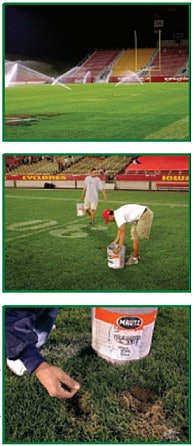With proper maintenance techniques, grass fields can endure drought, extreme temperatures and high use

Sports-turf management is a balancing act, one in which athletic field-maintenance levels must equal field-use levels. As usage increases, so should maintenance. And with so many communities and campuses across America experiencing space shortages, fields get used more than ever these days. That's why attaining the perfect balance is so important.
What can turf managers do to prolong the life of stressed fields that are susceptible to ever-changing weather variables and overuse? Simply put, anticipate the amount of use a field will receive, monitor weather patterns and then plan accordingly, says Boyd Montgomery, facilities and maintenance director for the Sylvania (Ohio) Recreation Corporation, who oversees 133 acres of fields at his community's Pacesetter Park and another 270 acres at local schools.
"This past year, we had about 250,000 people go through the Pacesetter facility," Montgomery says. "Aeration is the number-one thing that allows us to be successful with heavy clay-soil fields and our level of play. We'll aerate before spring play, when the season ends around May or June, and again just before the fall season starts. If we've had wet conditions, we'll core aerate and remove the cores each time. If conditions are drier, we'll either leave the cores to break up with the mowing process or drag them in. This also helps us manage our thatch layer."
At Iowa State University, athletic turf manager Mike Andresen aerates and top-dresses the heavily used soccer and football fields once a month during spring and summer until the first of August to develop adequate pore space and keep the root zones open. Compacted fields, he says, can repel water and are more susceptible to heat stress, which usually compounds problems. "Football hits at the toughest time of the year for our turf," Andresen says. "When your football teams hit the field in early fall, you'll soon see whether you got your summer maintenance program right or wrong."
Getting it right can be a challenge, especially with so many maintenance and treatment options. But here are some ways to revive stressed fields - from fertilization to field rotation - and ensure that maintenance levels remain consistent with usage levels all year long.
• Fertilization and mowing. No single fertilization program works for all fields. Rather, the most effective methods match the changing needs of the turf. "Our sand-based field fertilization is based on providing .60 of a pound of nitrogen every 17 to 21 days," Andresen says. "We'll start with a 1-to-1 nitrogen-to-phosphorus ratio and then will cut back a bit on the nitrogen, depending on tissue-test results." (Testing of the grass-plant tissue reveals the nutrients that are actually taken up by the plant, as opposed to soil tests, which determine the nutrients present in the soil.)
Andresen also monitors turf clippings. "If we see fewer clippings, we'll test to determine if we need to increase the fertilization rate or timing, or if the grass is showing stress and we need to reduce nutrition levels," he says.
Speaking of clippings, two schools of thought exist regarding mowing. The key is adopting the one that best fits a particular field's needs. Andresen and Montgomery both set their preferred height for the type of turf and type of play, then maintain that mowing height on each field throughout the growing season. Other turf managers opt to raise mowing heights during the summer to reduce stress associated with heat and drought, then gradually reduce the height to playing levels in the fall.
Researchers at Michigan State University recently measured how such critical field performance characteristics as density and recovery are affected by various cultural practices, and then determined the cost of such combinations on a per-field basis. Results of the research on the effect of various levels of fertilization and varying mowing frequencies - and of those two factors in combination with cultivation - were published in December 2002 in an MSU Extension bulletin titled "Optimizing Cultural Practices to Improve Athletic Field Performance."
Included within the "Seven Savvy Suggestions for Super Sports Surfaces" segment of the bulletin is the recommendation for mowing at least twice per week throughout the growing season. Also recommended is frequent fertilization (seven to 10 applications throughout the season) at nitrogen rates of no more than 0.5 pounds per 1,000 square feet per application.
• Drought and heat. In some ways, sports-turf managers know their fields like parents know their children. Therefore, determining whether a field is stressed and to what extent eventually becomes second nature. Like parenting, field maintenance can be tricky. "Too often, we lump drought pressure and heat pressure together as one stress, but the two are distinctly different," Andresen says.
Symptoms of drought stress may first appear as a change in color, with the turf taking on bluish-gray tints and footstep patterns lingering. Monitoring soil-moisture levels and weather conditions provides clues to when and how much water to apply to counteract that stress. Field-use scheduling and - in extreme situations - water-use restrictions become major factors in application rates and timing.
Ideally, irrigation should be used to balance the water loss indicated by monitoring evapotranspiration rates - that is, the amount of water needed to replace lost moisture. Because that often isn't possible, sports turf managers must rely on their training and experience to properly adjust the rates and timing of irrigation to alleviate the symptoms of stress. Adjustments may be needed daily or even hourly to compensate for microclimates created by such factors as the degree of sunlight or cloud cover, wind speed and direction, humidity levels and shade issues.
Relief from heat stress, on the other hand, usually requires a more measured approach. "If the grass blade doesn't look broad, full and healthy, if it shrinks up and gets a bluish-gray cast - almost, but not quite, a drought-stress appearance - it's time to relieve the heat stress," Andresen cautions.
Lightly applying just enough water to cool the turf, a process known as syringing, is considered the best way to do that. But opinions vary on exactly what constitutes syringing. "Take your finger, lick it and blow on it. That's just what you want syringing to do for the grass," Andresen says. "One revolution of the irrigation head will do it. A five- or ten-minute irrigation cycle can put down way too much water. I just want to wet the grass, to hit the top surface areas. I don't want a droplet of water to even reach the thatch layer. If I keep the mist on top, I don't rot the vegetative layer beneath. If I get the turf too wet I'll be able to feel it. It'll feel like a sauna beneath the canopy."
When heat pressures are intense, conditions must be continually monitored, because syringing may be required several times throughout the day. "Obviously, we'll monitor the temperatures and look at dew points, wind and humidity, but the real answer is out on the field," Andresen says. "We'll start on field checks in the morning, feeling into the thatch layer beneath the canopy to see how hot it is and how moist it is from the night before. Reflected heat intensifies inside stadiums. Early mornings and mid-afternoons are our periods to syringe the game field. The sun will tuck itself below the press box by mid- to late afternoon so the shade helps drop temperatures. We want to gauge the water so we go into night dry, which helps avoid disease outbreaks."
• Irrigation. Some communities implement stringent water restrictions or even water bans during specific times of the year, making effective water management on athletic fields even more challenging. Other areas of the country may experience late-winter snow and early-spring rain, making preparatory maintenance practically impossible. Indeed, last spring, many community baseball, softball and soccer games around the country were rescheduled because of wet conditions, increasing the stress on fields later in the spring and into early summer.
One advantage of irrigating athletic-field surfaces is that they are relatively flat, with only slight crowns on native soil fields. Thus, contending with runoff is not a problem. But this advantage is offset by the effects of water channeled to the fields via surrounding landscape - such as water gushing down from the top of the stadium bowl, an incident that can create near-flooding conditions for fields not designed to handle such deluges.
Irrigation systems tied into weather-system readings are a sophisticated and accurate method of precise irrigation control and can be programmed to monitor the evapotranspiration levels and deliver the exact amount of water needed to replace lost moisture. With moisture levels maintained at or near optimum conditions, turf stress is reduced, resulting in a healthier turf and significantly reduced water use.
As is the case at all facilities, Pacesetter Park displays a variety of field conditions. All have a base of native, heavy clay soil. The 69 acres of Kentucky bluegrass or perennial ryegrass game fields have in-ground irrigation systems, while the 64 acres of practice space are irrigated with four mobile waterwheel units. "Because our area is growing so quickly, we didn't want to lock in all of our field space, so we opted not to install inground irrigation on the practice fields," Montgomery says. "We use turf-type tall fescue on these practice areas, which allows us to keep good turf cover with less water. Fescue does take a while to establish itself and alleviate clump issues. But our fields are now three and four years old, and we've established a good, thick turf cover that holds up well to our level of use."
Montgomery monitors turf and soil conditions daily, adjusting irrigation to meet that specific day's needs, and he uses soil probes to check subsurface moisture and heat levels. With heavy clay soils, too much water can be more of a problem than too little. Wet fields don't bear traffic as well and are more susceptible to diseases. "Our heaviest play comes on Saturdays and Sundays, when we may have 20 to 30 fields in use," he says. "We'll try to go into the weekend as dry as we can without stressing the turf, so the ground can handle a rain event and still be in playable condition. The irrigation system will be off, and we will turn it on only when conditions warrant. If predicted rainfall doesn't occur and the fields get a bit too dry, we can program a quick cycle to put down just enough moisture to satisfy the turf's needs."
At Iowa State, all of the sand-based fields have in-ground irrigation systems, but some of the native soil fields do not. "After the spring season, we may have the option of pulling some of the non-irrigated fields from the summer-use cycle," Andresen says. "If, by mid-June or early July, we can manage the maintenance window to reestablish turf conditions that are strong enough to handle fall play, it's beneficial to encourage these fields to go dormant. This will reduce water use and may give us less disease pressure."
But a summer of dormant turf doesn't necessarily make for clean, healthy turf when it comes out of dormancy, Andresen warns. "It just introduces another level of disease and drought pressure. Trading one set of problems for another set is one way to look at it," he says.
Andresen and Montgomery both note that any fields hosting summer activities need to be irrigated. The traffic dictates it, as use causes grass blades to lean over enough to eliminate the canopy of shade needed to keep the plant protected without irrigation.
While irrigation can keep cool-season turf going during the hottest periods, it can't prevent every problem. "Our sand-based football game and practice fields are fully irrigated," Andresen says. "Yet, we experienced a point where the field flashed, meaning the grass just shut down, dropped leaves and flattened. The turf was under heat stress and we fertilized it. The push of the fertilizer boost and regular irrigation, combined with the degree of heat stress, put the turf over the edge. This was three weeks before the start of the 2002 football season. We did some syringing to keep the canopy temperatures lower and cut off the nitrogen fertilization. We also cut the fertility program and nursed the turf back from the stress level before we gradually introduced fertilization again."
• Disease. Stressed turf is disease-susceptible turf. The better the turf health and strength, the more disease pressure it can withstand. Integrated Pest Management (IPM) practices are the industry standard for dealing with pest issues. IPM is an environmentally responsible system of pest control that combines observation and cultural management practices with preventive and corrective control measures to keep pest activity from causing unacceptable damage.
Under IPM practices, turf is monitored regularly to analyze its condition and detect any signs of damage. Early stages of damage trigger the first level of action, which generally will involve such cultural adjustments as altering fertilization, mowing or irrigation programs to create environmental conditions less likely to allow more damage to occur. If the damage continues to escalate, more aggressive levels of action are applied, usually involving either spot application or full-field application of control products.
Strong bluegrass fields, for example, may withstand a mild attack of dollar spot or brown patch, or they may only require spot treatment with control products. If conditions persist, though, a preventive application may be a better plan. It all comes down to monitoring conditions and field-use patterns throughout the year and knowing how your fields are likely to react.
"We'll step up our disease-control program by the start of July to prevent infestations that could damage safety or playability," Andresen says. "We will make preventive applications only if conditions are conducive to specific diseases. There is so much fluidity with products going on and off the market that we take a proactive approach, digging into the university research reports, checking out test plots, visiting suppliers' web sites, and conferring with other sports turf managers and university experts to select the most effective products."
• Overseeding. The key to overseeding is keeping ahead of the game. Sports turf managers strive to gain back as many grass plants during the weekly recovery period as were lost during practices and games.
"We overseed using pregerminated bluegrass until the first of October, then switch to 100 percent perennial ryegrass," Andresen says. "On the football field, we'll fill divots first, then broadcast whatever remains of the divot mix for the players to dig in with their cleats as a method of planting the seed by pushing it into the ground for better seed-to-soil contact. We'll also use turf covers on that field as temperatures drop to force germination and turf growth. We consider any late-season overseeding on the native-soil practice fields dormant seeding. Weather conditions generally are too cool to allow germination at that time, but the seed is in place and ready to germinate when things warm up sufficiently in the spring."
At Pacesetter, overseeding starts as spring sports wind down in mid-May. "The lacrosse fields need the most work," Montgomery says. "We may have to use sod from our onsite sod farm for the goal areas to get the results we want. Our overseeding program gets more aggressive in the fall, with weekly overseeding during the playing season. It directly relates to ground temperatures. Once we reach around 55 degrees, we'll cut back again. Unless the season is unusually wet, we'll actually have more wear in the traffic patterns spectators use to get to the fields than we have in the playing areas."
• Field rotation. Innovative field rotation spreads the wear. The Iowa State football practice area is actually a field and a half, with the basic field layout lined in white. This space can be broken into three fields, lined in red and perpendicular to (but directly on top of) the white field.
"We're also able to use the university's recreational fields for summer camps, summer conditioning and for fall two-a-day practice sessions," Andresen says. "This allows us to rest our practice fields from late April until approximately the third week of August."
At Pacesetter, sunlight angles are a factor in field rotation. "We don't use an east-west layout because of the late-fall sun issues," says Montgomery. "We are as creative as possible in making north-south adjustments. In one section, covering about 12 acres of game area, we can line six soccer fields with the available space and then, during the fall season, swap the fields so the wear area from the spring is completely away from the current field area."
All of these stress-reduction strategies for fields run the risk of failure if you forget the most important element of any program: proactive communication with athletic departments, event schedulers, coaches and user groups. With good communication and cooperation, you and your fields can meet both daily and seasonal challenges.



































